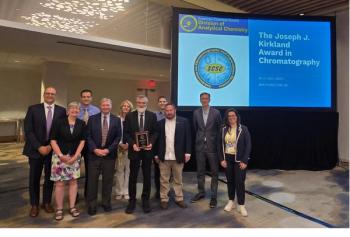
- January 2023
- Volume 41
- Issue 1
- Pages: 8–12
What Are My Options to Improve My Separation? Part I: Foundational Concepts

When considering different ways to improve an established LC method, it helps to start by reviewing some essential concepts.
Many high performance liquid chromatography (HPLC) users are confronted with questions about how to improve the performance of an existing or recently developed method. These days, we have many technological options to consider (for example, using higher pressures or temperatures, or both), but how do we choose one (or a few) to try? A systematic approach to method improvement can save time and resources by using methods that are likely to be better, and more robust, than those developed using a trial-and-error approach.
During a recent visit to a local laboratory here in Minnesota, I was asked a question that I initially thought would be easy to answer, but then it caused me to pause and think a lot. And the more I thought about it, a series of “LC Troubleshooting” articles unfolded in my mind, and this will be a frequent discussion topic here in 2023. The essence of the question was (paraphrasing) as follows: “I’ve got this validated method that isn’t great, but it gets the job done. The method is approximately 20 years old, and I’ve heard and read that high performance liquid chromatography (HPLC) technology has changed a lot in 20 years, so it seems to me it must be possible to improve this separation a lot. What are my options for doing that?”
Of course, as someone deeply committed to all things chromatography, I immediately felt the urge to say, “Why yes, a lot has changed, and you can improve that separation. But...you have a lot of options, and...it’s a little complicated.” Nevertheless, I am certain there are many HPLC users that have this exact question on their minds, and feel unsure about where to start. In a series of “LC Troubleshooting” articles, we are going to confront this question directly and make it more manageable to think about how to proceed. Not all of the options we will discuss will be available to all users, but it is valuable to understand what the full array of options looks like, so that you can feel confident in making an informed decision about how to proceed.
Some Analytical Challenges Need To Be Treated Differently
HPLC users routinely face a staggering variety of analytical challenges ranging from relatively fast (tens of seconds) separations of just a few analytes to long separations (several hours) of complex mixtures that contain thousands of analytes. Figure 1 shows a comparison of chromatograms obtained for simple and complex mixtures using contemporary technologies. In the case of the simple mixture, there is a lot of empty space in the chromatogram, and one means of decreasing analysis time would be to reduce the amount of wasted, empty space. On the other hand, the entire chromatogram for the complex sample is full of peaks. In this case, improvement may mean decreasing the peak widths on average so that fewer analytes are coeluted, but it is very unlikely that all of the analytes in the mixture can be fully resolved, even if the analysis time is extended beyond one hour. These disparate challenges necessarily require different chromatographic solutions, and improving on old or poor separations in current use for these applications require different lines of thinking.
When dealing with relatively simple mixtures, we generally have more paths to improve the separation, including changing mobile-phase chemistry, the stationary-phase chemistry, or both, adjusting the retention and optimizing efficiency (that is, finding the most time efficient way to achieve the chromatographic efficiency needed to meet the chromatographic objectives). On the other hand, when dealing with complex samples, our options are more limited. A big difference is that changing the mobile-phase chemistry, the stationary-phase chemistry, or both, will move peaks around, but there will still be coelution, so a simple reordering of the peaks may not be all that helpful—and usually mass spectrometry (MS) is critically helpful for resolving compounds that are not separated chromatographically. In this case, the most effective way of improving the separation would be to improve the efficiency as a means of improving the peak capacity—roughly, the number of peaks that can be fit side-by-side into a separation space. We will discuss the concept of peak capacity in more detail in a future installment focused on improving separations of complex mixtures.
The Menu of Options
Relative to the situation 20 years ago, HPLC users currently have many options to consider as possible means to improve upon the performance of old methods. Some of the most prominent options currently are changes in particle morphology and size, operating pressure, column temperature, and an increasingly diverse array of stationary-phase chemistries (for example, consider the growing number of “mixed-mode” phases that contain both charged and lipophilic functional groups). We can roughly divide these options into two categories: those that affect peak width (kinetic adjustments), and those that affect peak spacing, or relative retention (thermodynamic adjustments). Here, I provide a full list of options simply to make the point that there is a lot to consider. We won’t discuss any one of these in detail now, but we will discuss each of them in detail in future installments in this series.
- Kinetic adjustments—reducing peak width relative to analysis time, which include:
- changing the particle size (usually decreasing it, but not always);
- moving to a higher pressure range (allows increase in flow rate, increase in column length, decrease in particle size, or both);
- moving to a higher temperature range (allows increase in flow rate, increase in column length, decrease in particle size, or both); and
- changing the particle morphology(for example, moving from totally porous particles to superficially porous ones).
- Thermodynamic adjustments—improving peak spacing (that is reducing the fraction of the time axis that is empty), which can include:
- finding a stationary-phase chemistry that provides more even distribution of peaks across the time window;
- adjusting the mobile-phase chemistry in a way that moves toward more even distribution of peaks; and
- adjusting the column temperature can also be considered here.
Resolution is a Key Metric of Separation Performance in This Context
There are many ways to measure separation performance, including analysis time, efficiency (that is, plate number), selectivity, retention, and resolution. Among these, resolution (RS) is one of the more holistic measures of performance because it takes into account both the difference between retention times of adjacent peaks (which is related to selectivity), and their widths (which is related to plate number). This is shown in equation 1, where tR,A and tR,B are the widths of the first and last eluting members of a peak pair, and wA and wB are their 4·σ widths (measured at 13.4% of the peak height).
Even if there is a good distance between the peaks as measured by their retention times (let’s say 1 min), they will not be resolved if they are very wide (>>1 min). Conversely, even if the peaks are very narrow (let’s say 1 s), they will not be resolved if there is no distance between them (<<1 s). Thus, successfully resolving two peaks requires at least some minimal distance between them and that they be reasonably narrow. Of course, there is some room for variation here—the narrower the peaks are, the smaller is the distance between them that is needed, and the more distance between the peaks there is, the wider the peaks can be while still actually resolving them.
Whenever discussing resolution, I think it is valuable to have in our minds a correspondence between the calculated resolution values, and what the separation looks like in a chromatogram. A few examples are shown in Figure 2 to reiterate this important point.
Effects of Efficiency, Selectivity, and Retention on Resolution
Given the importance of resolution as a metric of separation performance, discussions of the effects of different chromatographic variables on performance are often focused on their effects on resolution. Equation 2, sometimes referred to as the Purnell equation (1,2), shows an approximate expression for resolution that makes explicit the relationships between resolution and plate number (N), retention factor (k), and selectivity (α).
where α is defined as the ratio of the retention factors of the two peaks we are trying to resolve (α = kB/kA). We might think about this kA expression as the three-legged stool of resolution—without any of the legs, the stool will fall over, and we will not have the resolution we need. From this follow some basic but essential tenets of method development:
- We must have some retention. If there is no retention (k = 0), there cannot be any resolution (RS = 0), no matter how good the plate number and selectivity might be.
- We must have some selectivity. If there is no selectivity (kA = kB; α = 1), there cannot be any resolution (RS = 0), no matter how good the plate number and retention might be.
- We must have some chromatographic efficiency (N). If the plate number is very low, then resolution is likely to be low.
Now what is particularly interesting is that although each of the three legs of the stool is essential for success (N, k, and α), some of them are more impactful than others. Figure 3 shows the impact of each variable on resolution when the remaining two are held constant. First, we see that increasing N from zero has an immediate positive impact on resolution, but then the impact diminishes because of the square root dependence of RS on N. Second, we see that increasing k from zero has an even larger positive effect on RS initially, but then the effect diminishes quickly, because k/k + 1 ~ 1 when k > 5. Finally, we see that increasing the selectivity, α, has the most persistent effect on increasing resolution. Increasing α from 1.10 to 1.15 has almost the same degree of impact on RS as increasing a from 1.00 to 1.05. Given the strength and persistence of this impact, we should always seriously consider how to change α in the process of trying to improve an existing separation, whether the desired improvement is focused on improving resolution in a given analysis time, or achieving the same resolution in a shorter analysis time. There are many possible ways to change selectivity, and we will discuss these in detail in future installments. For now, it is most important to embrace the relationships shown in Figure 3 and always have these in mind when considering how to improve an existing separation.
Summary
Many HPLC users are confronted with questions about how to improve upon the performance of an existing method. Fortunately, modern HPLC technologies (that is, instrumentation, columns, and software) provide many possible avenues to make improvements. However, the number of possibilities can be intimidating, making it difficult to decide upon a particular path to improvement. In this installment of “LC Troubleshooting,” I have discussed the essential concepts to keep in mind when considering different ways to improve a method, including how to measure performance, a summary of different technology options that should be considered, and the impact of different chromatographic variables on resolution. In future installments in this series, we will look at each of these topics in detail, surveying contemporary technologies and their potential impact on performance, all with the goal of providing users with a foundation of knowledge to support confident decisions about how to proceed with method improvement.
References
(1) Purnell, J.H. The Correlation of Separating Power and Efficiency of Gas- chromatographic Columns. J. Chem. Soc. 1960, 1268–1274.
(2) L.R. Snyder; J.J. Kirkland; J.W. Dolan. Basic Concepts and the Control of Separation, in: Introduction to Modern Liquid Chromatography (Wiley, Hoboken, NJ, 3rd ed., 2010), pp. 69–71.
(3) Sandra, P. and David, F. In Multidimensional Chromatography: Techniques and Applications, H. Cortes, Ed. (Marcel Dekker, New York, NY, 1990).
ABOUT THE COLUMN EDITOR
Articles in this issue
Newsletter
Join the global community of analytical scientists who trust LCGC for insights on the latest techniques, trends, and expert solutions in chromatography.





